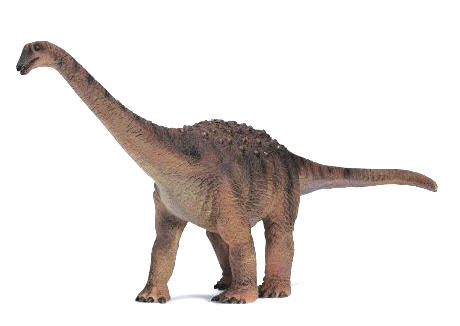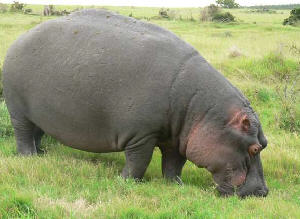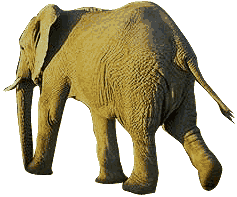Does the Bible Describe Dinosaurs in Job 40 and 41?
© 2008-2020, Glen J. Kuban

|
| Model of Saltasaurus, a sauropod dinosaur |

|
| Model of Saltasaurus, a sauropod dinosaur |
Many young-Earth creationists (YECs) assert that the book of Job in the Bible describes dinosaurs, and that in particular the creature called "Behemoth" in Job 40 describes a sauropod--one of the huge, long-necked, four-legged dinosaurs informally known as "brontosaurs." Some YEC authors also suggest that the "leviathan" of Job 41 may also refer to a dinosaur or dinosaur like creature.
However, most Biblical scholars believe the creatures in Job refer to mythical or metaphorical creatures, or modern creatures with some artistic license taken in their descriptions. For example, no creature (modern or ancient) would actually possess limbs of "iron" or drink up an entire river, so we must be cautious not to take other parts of the passages a strictly literal sense. We must also fully consider the context of the passages and important linguistic considerations. When done, it is seen that the descriptions are at least as compatible with modern as ancient creatures, and on balance, favor the former.
Moreover, as maintained by virtually all conventional geologists, humans and non-avian dinosaurs are separated by approx. 65 million years. Although YECs dispute this, even the major creationist group "Answers in Genesis" acknowledges that there are no convincing remains of dinosaurs found with humans or any other large modern mammal [1], which would not be expected if they all lived at the same time a few thousand years ago.
Before getting into arguments against the dinosaurian interpretation, it should be mentioned that even if the passages describe dinosaurs, there are two possibilities that do not require that humans and dinosaurs be contemporaries. First, the accounts could have been based on fossil skeletons. Nowhere do the passages in question clearly indicate that currently or recenty existing animals are being described. Second, as suggested by Jerry MacDonald in his book Behold the Behemoth, the accounts could be written from God's omniscient viewpoint--just as a number of other Old and New Testament verses that did not involve human witnesses, and in some cases could not have. After all, the chapter begins with the words "Lord said to Job...".
All of this is somewhat moot unless a rigorous case can be made that the passages in question describe dinosaurs, and at best the evidence for this is equivocal. Let us address Job 40 first. Traditionally, Bible scholars and historians have suggested that if the animal alluded to is a real one, the hippopotamus or elephant are the most likely candidates, with the former somewhat more probable. Indeed, a careful and thorough study of the passage in question supports this conclusion. As noted in Clarke's Commentary: "These, having been carefully considered and deeply investigated both by critics and naturalists, have led to the conclusion that either the elephant, or the hippopotamus or river-horse, is the animal in question; and on comparing the characteristics between these two, the balance is considerably in favor of the hippopotamus."[2]
Let us examine the specific verses in question (KJV):
15 Behold now behemoth, which I made with thee; he eateth grass as an ox.
16 Lo now, his strength is in his loins, and his force is in the navel of his belly.
17 He moveth his tail like a cedar: the sinews of his stones are wrapped together.
18 His bones are as strong pieces of brass; his bones are like bars of iron.
19 He is the chief of the ways of God: he that made him can make his sword to approach unto him.
20 Surely the mountains bring him forth food, where all the beasts of the field play.
21 He lieth under the shady trees, in the covert of the reed, and fens.
22 The shady trees cover him with their shadow; the willows of the brook compass him about.
23 Behold, he drinketh up a river, and hasteth not: he trusteth that he can draw up Jordan into his mouth.
24 He taketh it with his eyes: his nose pierceth through snares.
 In regards to verse 15, the Hebrew word for grasses apparently does refer to actual grasses and possibly other low lying
vegetation--not rough shrubs and trees, which were evidently the main food of sauropods, judging by their teeth and other features.
Moreover, no clear fossil evidence of grasses even exists in the Jurassic, when most sauropods lived
(although some continued into the Cretaceous). In contrast, and better fitting the passages, hippos and elephants
eat a variety of vegetation, and among their common foodstuffs are grasses and grains. In the evening, hippos will
often come out of the water to "graze" on grasses in nearby fields. Ancient Egyptians referred to the hippopotamus as the "water-ox."
According to Wikipedia, the Russian meaning of behemoth is "hippopotamus."
In regards to verse 15, the Hebrew word for grasses apparently does refer to actual grasses and possibly other low lying
vegetation--not rough shrubs and trees, which were evidently the main food of sauropods, judging by their teeth and other features.
Moreover, no clear fossil evidence of grasses even exists in the Jurassic, when most sauropods lived
(although some continued into the Cretaceous). In contrast, and better fitting the passages, hippos and elephants
eat a variety of vegetation, and among their common foodstuffs are grasses and grains. In the evening, hippos will
often come out of the water to "graze" on grasses in nearby fields. Ancient Egyptians referred to the hippopotamus as the "water-ox."
According to Wikipedia, the Russian meaning of behemoth is "hippopotamus."

YECs often emphasize verse 17, "He moveth his tail like a cedar", arguing that sauropods have very large tails, whereas hippos and elephants have relatively small tails. However, the passage does not say that the tail was like a cedar tree in size, only in movement. In this regard, the verse might well be referring to the movement of a cedar branch or switch, not the whole tree. Moreover, Michael Bright suggests that the description may refer to bristles resembling the cedar's needle-like leaves which are present on the tails of elephants and hippopotami.[2b] Also important, but almost never mentioned by YECs, is that the Hebrew word usually translated as "tail" here can also refer to other appendages of an animal, including a trunk. In fact, as uncomfortable as it may be to some, the word can and sometimes was used in ancient Hebrew to refer euphemistically to a large penis. Scholars favoring this interpretation here note that a hippo and elephant each have a penis that when erect, extends several feet in length, and that the term for "move" can also mean "extend." Further lending credence to this interpretation, is that the passages before and after the one in question refer to the animal's strength being in its loins, and the "sinews of his stones". Indeed, the Hebrew word for "stones" here can refer (as even in casual English today) to testicles rather than actual stones. In some Bible translations the word is even rendered that way, [3, 3b] although most modern translations use the term "stones" or "thighs."
Verse 18 obviously uses figurative terms and does not help distinguish between a variety of possible animals. Some commentators suggest that the entire passage is largely figurative, and may refer to no real creature (living or extinct), but rather a mythical creature or entirely metaphorical one. As evidence of the potentially broad and diverse use of the term "behemoth", note the following uses:
I will send against them the fangs of behemoth, the venom of vipers that glide in the dust. (Deut 32:24 NIV)
When my heart was grieved and my spirit embittered, I was senseless and ignorant; I was behemoth before you. (Ps 73:21 NIV)
Here we seem to see at least one kind of "behemoth" that is potentially fearsome and aggressive. Note that hypos and elephants are both known to be aggressive when threatened or disturbed (with both having huge teeth/tusks that can inflict severe damage on any victim of their wrath), whereas sauropods had rows of small, peg-like teeth. The meaning of verse 19 of Job 40 is uncertain, but also may emphasize the aggression or fierceness of the creature. This too might best fit the hippo, which is known to be the most dangerous animal in Africa, based on the number of human deaths each year.
Verse 20 seems to develop the picture of a largely aquatic animal, whose food is carried to him presumably in the water. Since sauropods were evidently primarily terrestrial, this verse seems to disfavor the sauropod interpretation, and favor a hippopotamus, or perhaps less strongly, an elephant.
Verses 21-22 suggest the animal could easily be shaded under shoreline trees or shrubs, which would be far more difficult for a large sauropod (the largest land animals that ever lived) than a hippo or elephant. The NASB translation renders the passage as: "Under the lotus plants he lies down, the willows (reeds) of the brook surround him." Greg Neyman notes that it is difficult to imagine a large sauropod, which can reach 100 feet long and 70 feet high when standing (sitting, probably 20 feet tall), "resting under the short limbs of a lotus plant (or, tree), nor would he be able to take cover in reeds only a few feet tall."[4]

Verse 23, indicating that the beast "drinketh up a river," and "can draw up Jordan into his mouth" is yet another passage that seems to favor some creature other than a sauropod. Obviously no animal can drink up a river literally, but a hippo with its great mouth agape would more inspire such an image than the relatively tiny head and mouth of a sauropod. An elephant gulping or suctioning and then spraying out a fountain of water might also inspire such a metaphor. Greg Neyman adds, "The New American Standard version states "If a river rages, he is not alarmed; He is confident, though the Jordan rushes to his mouth. Given the smallness of the sauropod's mouth, this is an unlikely sight-picture."
Verse 24 does not seem particularly useful in distinguishing among candidates, but as with other verses, seems to imply an aggressive animal. In conclusion, when all linguistic aspects of the passages and anatomic aspects of the candidate animals are considered, Job 40 seems more compatible with a hippo or elephant (more so the former) than a sauropod dinosaur.

|
| Crocodile skull |
One might also ask more generally, if dinosaurs or (as YECs maintain) all prehistoric animals existed alongside humans only a few thousand years ago, why there are no unambiguous descriptions in the Bible or other ancient literature of any of the thousands of remarkable prehistoric animals, including scores of dinosaurs such as ceratopsians, hadrosaurs, stegosaurs, as well as countless impressive non-dinosaurian prehistoric creatures such as pterosaurs, pelycosaurs, plesiosaurs, titanotheres, etc. Moreover, the idea that dinosaurs existed with humans contrasts extensive geologic and paleontological evidence, including the absence of any convincing humans remains (or those of any other large modern mammal) with dinosaurs, or even at the same geologic horizons--which stands in sharp contrast to the YEC assertion that all such animals were living at the same time only a few thousand years ago.
[2] Clarke, Adam, Clarke's Commentary, at: http://www.godrules.net/library/clarke/clarkejob40.htm
Bright, Michael, 2006. Beasts of the Field: The Revealing Natural History of Animals in the Bible, p346. 1861058314.
[3] Jack DeBaum writes: "Hebrew scholars have long asserted that the "tail" in this verse was merely a euphemism for the male genital organ. According to "John Gill's Exposition of the Entire Bible" (available on the Internet), "tail" in this verse is interpreted as "penis" by the Targum in the King's Bible, and Cicero confirm that ancients used to refer to the penis as the "tail". This interpretation is lent further credence by that fact that discussion of this organ is followed by a description of the beast's "stones" which the Targums equate with the testicles. That being the case, it is reasonable to assume that the comparison of the "tail" with a tree was metaphorical and that it was intended to convey the impressive dimensions of this appendage. In accordance with these interpretations, this passage is rendered by translator Stephen Mitchell to read, "Behold now the Beast" His penis stiffens like a pine; his testicles bulge with vigor." (http://www.netw.com/tknapp/debaun2.htm)
[3b] Mitchell, Stephen, 1987. The Book of Job. San Francisco: North Point Press. Cited in R. T. Pennock, 1999, Tower of Babel, Cambridge, MA: MIT Press. In regards to the possibility that the term "stones" refers to testicles, Michel notes that the Vulgate uses the word "testiculorum".
[4] Neyman, Greg, "Job 40-41: Dinosaurs in the Bible?" Answers in Creation website, at: http://www.answersincreation.org/job4041a.htm
1 Canst thou draw out leviathan with a hook? or his tongue with a cord which thou lettest down? 2 Canst thou put a hook into his nose? or bore his jaw through with a thorn? 3 Will he make many supplications unto thee? will he speak soft words unto thee? 4 Will he make a covenant with thee? wilt thou take him for a servant for ever? 5 Wilt thou play with him as with a bird? or wilt thou bind him for thy maidens? 6 Shall the companions make a banquet of him? shall they part him among the merchants? 7 Canst thou fill his skin with barbed irons? or his head with fish spears? 8 Lay thine hand upon him, remember the battle, do no more. 9 Behold, the hope of him is in vain: shall not one be cast down even at the sight of him? 10 None is so fierce that dare stir him up: who then is able to stand before me? 11 Who hath prevented me, that I should repay him? whatsoever is under the whole heaven is mine. 12 I will not conceal his parts, nor his power, nor his comely proportion. 13 Who can discover the face of his garment? or who can come to him with his double bridle? 14 Who can open the doors of his face? his teeth are terrible round about. 15 His scales are his pride, shut up together as with a close seal. 16 One is so near to another, that no air can come between them. 17 They are joined one to another, they stick together, that they cannot be sundered. 18 By his neesings a light doth shine, and his eyes are like the eyelids of the morning. 19 Out of his mouth go burning lamps, and sparks of fire leap out. 20 Out of his nostrils goeth smoke, as out of a seething pot or caldron. 21 His breath kindleth coals, and a flame goeth out of his mouth. 22 In his neck remaineth strength, and sorrow is turned into joy before him. 23 The flakes of his flesh are joined together: they are firm in themselves; they cannot be moved. 24 His heart is as firm as a stone; yea, as hard as a piece of the nether millstone. 25 When he raiseth up himself, the mighty are afraid: by reason of breakings they purify themselves. 26 The sword of him that layeth at him cannot hold: the spear, the dart, nor the habergeon. 27 He esteemeth iron as straw, and brass as rotten wood. 28 The arrow cannot make him flee: slingstones are turned with him into stubble. 29 Darts are counted as stubble: he laugheth at the shaking of a spear. 30 Sharp stones are under him: he spreadeth sharp pointed things upon the mire. 31 He maketh the deep to boil like a pot: he maketh the sea like a pot of ointment. 32 He maketh a path to shine after him; one would think the deep to be hoary. 33 Upon earth there is not his like, who is made without fear. 34 He beholdeth all high things: he is a king over all the children of pride.1